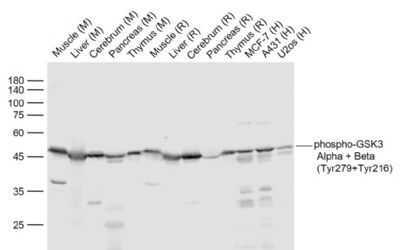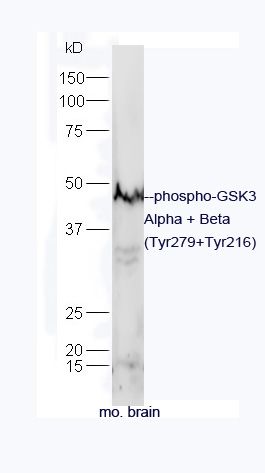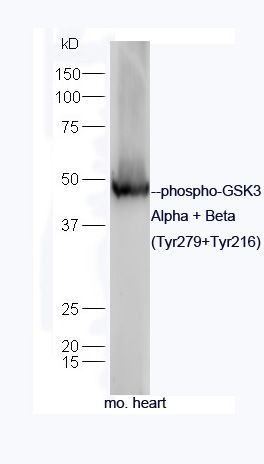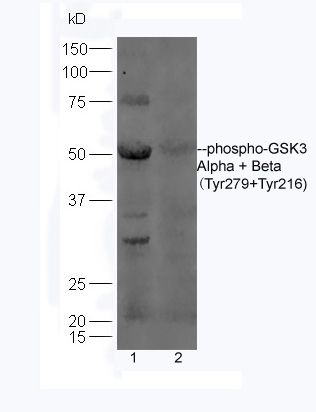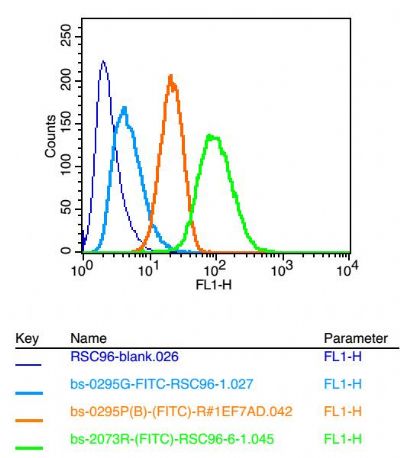Sample:
Lane 1: Muscle (Mouse) Lysate at 40 ug
Lane 2: Liver (Mouse) Lysate at 40 ug
Lane 3: Cerebrum (Mouse) Lysate at 40 ug
Lane 4: Pancreas (Mouse) Lysate at 40 ug
Lane 5: Thymus (Mouse) Lysate at 40 ug
Lane 6: Muscle (Rat) Lysate at 40 ug
Lane 7: Liver (Rat) Lysate at 40 ug
Lane 8: Cerebrum (Rat) Lysate at 40 ug
Lane 9: Pancreas (Rat) Lysate at 40 ug
Lane 10: Thymus (Rat) Lysate at 40 ug
Lane 11: MCF-7 (Human) Cell Lysate at 30 ug
Lane 12: A431 (Human) Cell Lysate at 30 ug
Lane 13: U2os (Human) Cell Lysate at 30 ug
Primary: Anti-phospho-GSK3 Alpha + Beta (Tyr279+Tyr216) (SL2073R) at 1/1000 dilution
Secondary: IRDye800CW Goat Anti-Rabbit IgG at 1/20000 dilution
Predicted band size: 47’51 kD
Observed band size: 47 kD
Sample:
brain (Mouse) Lysate at 40 ug
Primary:Anti-phospho-GSK3Alpha+Beta(Tyr279+Tyr216)(SL2073R)at1/300 dilution
Secondary: IRDye800CW Goat Anti-Rabbit IgG at 1/20000 dilution
Predicted band size: 47/51 kD
Observed band size: 47 kD
Protein:Heart(Mouse) lysate at 30ug;
Primary: Anti-phospho-GSK3 Alpha + Beta (Tyr279+Tyr216) (SL2073R) at 1:300 dilution;
Secondary: HRP conjugated Goat-Anti-rabbit IgG(SL0295G-HRP) at 1: 5000 dilution;
Predicted band size: 47/51 kD
Observed band size: 47 kD
Sample:
Lane1: Brain (Mouse) Lysate at 30 ug
Lane2: Testis(Mouse) Lysate at 30 ug
Primary: Anti-phospho-GSK3 Alpha + Beta (Tyr279+Tyr216) (SL2073R) at 1:300 dilution;
Secondary: HRP conjugated Goat-Anti-rabbit IgG(SL0295G-HRP) at 1: 5000 dilution;
Predicted band size:47/51 kD
Observed band size:50 kD
Positive control: RSC96
Isotype Control Antibody: Rabbit IgG;
Secondary Antibody: Goat anti-rabbit IgG-FITC;
Dilution: 1:200 in 1 X PBS containing 0.5% BSA
Primary Antibody catalog number: SL2073R;
Dilution: 3μL in 100 μl 1X PBS containing 0.5% BSA
|
